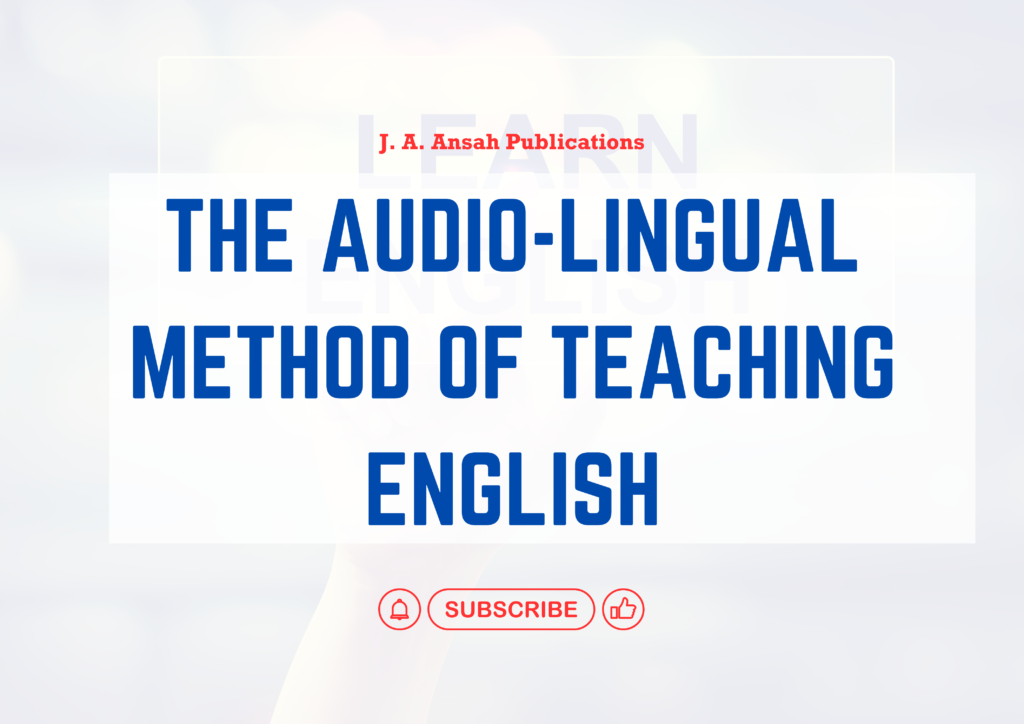BY J. A. ANSAH
INTRODUCTION
Skinner’s Behaviourism theory assumed that a human being can be trained using a system of reinforcement. Appropriate behaviour receives positive feedback, while errors receive negative feedback. This approach to learning is similar to the Direct Method, in that the lesson takes place wholly in the target language.
THE HISTORY OF THE METHOD
Audiolingualism came about as a result of a number of developments in linguistics, psychology and politics. In the 1940s, linguists at the University of Michigan and other universities were engaged in developing materials for teaching English to foreign students studying in the U.S. Their approach, based on structural linguistics, relied on a contrastive analysis of the students’ native language and the target language, which they believed would identify potential problems in language learning. Lessons consisted of intensive oral drilling of grammatical patterns and pronunciation. The approach became known variously as the Oral Approach, the Aural-Oral Approach, or the Structural Approach.
At approximately the same time, the United States was drawn into World War II and needed personnel who were fluent in foreign languages. Upon finding a lack of Americans with sufficient language skills, in 1942 the U.S. government developed the Army Specialised Training Program, an oral-based program based on intensive drilling and study. The success of this program convinced a number of prominent linguists of the value of an intensive oral approach to language learning. Most American schools and universities, however, continued to employ the Grammar-Translation Method or the Reading Method well into the 1950s.
In 1957 Russia launched Sputnik, the first artificial satellite, causing the U.S. government to become concerned about Americans’ isolation from scientific advances in foreign countries due to their lack of proficiency in foreign languages. The National Defense Education Act of 1958 provided funds for developing foreign language teaching materials and training teachers, and language teaching specialists set about developing new teaching methods. They drew upon the earlier Structural Approach and the Army program, as well as on principles of behaviourist psychology. The new approach, which Yale professor Nelson Brooks dubbed audio-lingual, claimed to have transformed language teaching into a science.
The Audiolingual Method was widely adopted in the U.S. and Canada and served as the principal approach to foreign language teaching in the 1960s. The method’s decline in the late 1960s and early 1970s was brought about by two factors. First, linguist Noam Chomsky questioned the theoretical basis for the method, particularly the assumption that external conditioning could account for all language learning (Chomsky, 1959). Second, some language teachers and students experienced frustration with the method’s avoidance of grammar explanations, its heavy emphasis on rote memorisation and drilling, and its failure to produce conversational ability in the foreign language (Hadley, 2001). These developments led to the eventual abandonment of the method, although some of its practices, such as dialogue learning and pattern drills, continue to be used in some foreign language programmes.
The Audio-lingual Method was widely used in the 1950s and 1960s, and the emphasis was not on the understanding of words, but rather on the acquisition of structures and patterns in common everyday dialogue. These patterns are elicited, repeated and tested until the responses given by the student in the foreign language are automatic.
DEFINING THE AUDIO-LINGUAL METHOD
The audio-lingual method is another teaching approach that has been initially focused on speaking proficiency. An urgent need to review and restructure the learning process can be explained historically. The start of World War II made it more crucial than ever for Americans to learn the languages of both their enemies and friends. Consequently, fragments of the Direct Method were taken to create and reinforce this new approach, the “Army Method,” which eventually became known as the Audiolingual Method in the 1950s.
The main focus of the method was to shape the habit of using certain structures, patterns and verbs through repetition and drilling, and general extensive exposure to the examples that needed to be recreated. Developing the habit was supposed to help students improve their speaking skills and work with language acquisition on the physiological level.
THEORY OF LANGUAGE LEARNING
Audiolingualism views language as a set of structures, including phonemes, morphemes and syntax, the patterns of which can be deduced by analysing the language used by native speakers. The audiolingual syllabus is prearranged around these linguistic structures, which are embodied in dialogues and pattern drills.
A second tenet of audiolingualism is that language is primarily an oral phenomenon, inasmuch as all-natural languages first developed orally, and children learn their first language orally before learning its written form. Thus, the Audiolingual Method teaches listening and speaking before reading and writing. Exposing beginning students to the written language is avoided in the belief that seeing the written word interferes with developing correct pronunciation habits. Reading and writing are introduced later and consist primarily of material that was first learned orally.
The learning theory underlying the Audiolingual Method is behaviourism, a prominent school of psychological thought in the first half of the twentieth century. Behaviourism posits that all learning occurs as humans respond to external stimuli and their response is either rewarded or punished, which serves to increase or decrease the behaviour. Psychologist B. F. Skinner, in his 1957 book Verbal Behaviour, included language among the behaviours that are learned through this type of conditioning. Behaviourist theory is applied in the classroom, with teachers providing linguistic stimuli in the form of dialogues and drills, reinforcing students’ correct responses and correcting their errors.
The single paramount fact about language learning is that it involves, not problem solving, but the development and performance of habits. Because the formation of correct linguistic habits is paramount, great emphasis is placed on proper pronunciation, intonation and grammar usage. Students are discouraged from using language to create their own meaning due to the potential for making errors, which may potentially become ingrained habits.
THE KEY CHARACTERISTICS/PRINCIPLES OF THE AUDIO-LINGUAL METHOD
The key principles of the audio-lingual method are the following:
1. The teacher has to present a context which will be worth copying. This generally occurs through role-playing the dialogues or filling the gaps with the information students have heard in the audio.
2. Teachers must be very attentive to errors and do their best to correct them so that the wrong habit will not be developed. Nothing is worse than fossilisation.
3. The main goal is to teach students how to speak correctly. There is a great emphasis on pronunciation.
4. All the necessary words and structures should be drilled to the extent of automatic reproduction without taking any extra minutes to think.
5. No emphasis is placed on the explanation of grammar rules. Audio-lingual methods followers suppose that learning any language is similar to the acquisition of the native language. Consequently, rules can be induced from examples and practice.
6. Audio-lingual practitioners follow the “natural order” of developing language skills: listening, speaking, reading and writing.
7. Drills are used to teach structural patterns
8. Set phrases are memorised with a focus on intonation
9. Grammatical explanations are kept to a minimum
10. Vocabulary is taught in context
11. Audio-visual aids are used
12. Correct responses are positively reinforced immediately
13. Typical exercise types drills, substitution tables, imitation, transformation, sound discrimination, memorisation of dialogues
14. Role of teacher: provision of stimuli and reinforcement, drillmaster
15. Attitude to use of mother tongue: use of mother tongue avoided at the lesson, but possible difficulties predicted through comparative analysis.
CLASSROOM ACTIVITIES
A typical Audiolingual lesson begins with a dialogue, which is presented either from a recording or verbally by the teacher, often accompanied by drawings to illustrate the meaning. Lines from the dialogue are memorised one by one, with students repeating each line in chorus. When a pair of lines is learned, the teacher asks half of the class to repeat the first line, and the other half to respond by repeating the second line. The same procedure is repeated with rows of students and then with individual students.
When the dialogue has been memorised, the teacher leads students in adapting it to their own situation or interests by substituting words or phrases. Students repeat the dialogue with the new substitutions. Sentences containing key linguistic structures are then extracted from the dialogue to form the basis for pattern drills of different types. The teacher reads a sentence and asks students to repeat it in unison. The teacher subsequently leads the students in drills based on the model sentence.
Drills may include responding to questions, substituting new words or grammatical structures, negating affirmative sentences, or making morphological manipulations such as changing singular to plural, all according to the teacher’s cues. These drills are first practised in chorus and then individually. Any grammatical or pronunciation errors are corrected immediately by the teacher. Some grammatical explanation may be provided, but it is generally kept to a minimum. Follow-up activities may consist of reading, writing, or vocabulary activities, which are based on the dialogue and sentences that have been practised in class. If a language laboratory is available, students may do further drill work on structures and pronunciation using recordings of the dialogues and sentences.
STUDENTS’ POSITION
As for the students’ position in such a classroom, it can be described with the help of the following key requirements:
1. Students’ native language should be used as little as possible so that they do not lose focus on the target language.
2. Students are supposed to do their best to mimic the pronunciation of the examples presented by the teacher.
3. Students have to revise and repeat the target language and grammar structure as often as possible in order to develop the habit.
4. The vocabulary presentation is limited. Students have to pay much more attention to learning structural patterns rather than separate words. Loads of new vocabulary come later.
SOME HINTS FOR USING AUDIO-LINGUAL METHOD IN TEACHING ENGLISH:
1. The teacher should be careful to ensure that all of the utterances that students will make are actually within the practiced pattern. For example, the use of the auxiliary verb have should not suddenly switch to have as a main verb.
2. Drills should be conducted as rapidly as possible so as to establish a system.
3. Ignore all but gross pronunciation errors when drilling for grammar practice.
4. Use shortcuts to keep the pace of drills at a maximum. Use hand motions, signal cards, notes, etc to cue a response.
5. Use normal English stress, intonation and juncture patterns meticulously.
6. Drill material should always be meaningful. If the content words are not known, teach their meanings.
7. Combine short periods of drill (10 minutes) with very brief alternative activities to avoid fatigue and boredom.
Introduce the drill in this way:
a) focus (by writing on the board, for example) establish a system;
b) exemplify (by speaking model sentences);
c) explain (if a simple grammatical explanation is necessary);
d) drill.
9. Don’t stand at one place, move about the room standing next to as many different students as possible to check their production. Thus, you will know who to give more practice to during individual drilling.
10. Use the backward build-up technique for long and/or difficult patterns.
Sample:
– him;
– to him;
– to him;
– Give it to him.
11. Arrange to present drills in the order of increasing complexity of student’s response. The question is: «How much internal organisation or decision making must the student do in order to make a response in this drill»? Thus: imitation first, single-slot substitution next, free response last.
RATING THE EFFECTIVENESS OF THE AUDIO-LINGUAL METHOD
The audio-lingual method was initially created as the improved version of the direct method. It was supposed to pay much more attention to speaking and embrace the natural process of language acquisition. After 1964, its appeal declined, in part due to exposure of its flaws. Since it downplayed the importance of context and prior knowledge in language learning and placed an excessive amount of emphasis on memorisation and practice, it was unable to foster communicative competence a lot.
After all, it was found that mistakes were not always so harmful and even wanted, as the teacher knows where more attention should be paid. Plus, it was proved that language can’t really be learned by developing a habit in the way the audio-lingual method puts it.
PROS AND CONS
| Pros | Cons |
| Constant drills make students remember the materials for a very long time. | Students overlearn the information but might not really use it fluently outside of the memorised patterns. |
| Students have very good pronunciation as it is taught straight from the beginning. | Not enough attention is paid to the skills that are not oral. Hence, writing suffers a lot. Too little grammar and spelling exposure leads to a lot of writing mistakes. |
| Students also get a lot of context about the culture of the language they are learning through exposure to dialogues and texts. | Students do not get an explicit presentation of grammar, which is needed sometimes. Therefore, some grammar rules may stay vague. |
| Almost no L1 is allowed so students are focused on the foreign language all the time. | Errors are not allowed, and the students are pressured to reproduce the examples given by the teacher with no mistakes. |
OTHER ADVANTAGES INCLUDE:
– It aims at developing listening and speaking skills which is a step away from the Grammar-translation method.
– The use of visual aids has proven its effectiveness in vocabulary teaching.
– Authentic materials are utilised.
– Language items are presented in dialogues, not in isolation.
– Natural order of skills presentation: listening, speaking, reading, writing.
– Students could often see immediate results.
OTHER DISADVANTAGES INCLUDE:
– The drills are meaningless, no communication.
– Repetition is boring.
– Practice for the sake of practising
– Lack of flexibility.
– Overestimated role of drilling.
– No challenge for learners.
– Misinterpretation due to lack of explicit grammar rules
– The method’s insistence on repetition and memorisation of standard phrases ignored the role of context and knowledge in language learning.
DEVELOPMENTS & PROBLEMS
This extensive memorisation, repetition and over-learning of patterns was the key to the method’s success, as students could often see immediate results, but it was also its weakness. It was discovered that language was not acquired through a process of habit formation. The method’s insistence on repetition and memorisation of standard phrases ignored the role of context and knowledge in language learning. As the study of linguistics developed, it was discovered that language was not acquired through a process of habit formation, and that errors were not necessarily bad. It was also claimed that the methodology did not deliver an improvement in communicative ability that lasted over the long term.
USING THE TEACHING TECHNIQUES WITHIN THE AUDIO-LINGUAL METHOD
Memorising the Dialogues
Dialogues are considered the best examples to copy within the method as they have both useful structures and comprehensible context. That is why dialogues are not only role-played but also learnt by heart.
Various Forms of Drilling
Drillings are a must in the audio-lingual method. So, the whole spectrum is actively used: repetition and chain drill, substitution and transformation drill. And many more.
Fill in the Gaps
There is no better way to reproduce certain words within the context than fill-in-the-gaps tasks. They require understanding of the target language, knowledge of whether the word is appropriate in a certain structure, an ability to interact with a context, as well as the right spelling skills.
MODERN USAGE
The Audio-lingual Method is still in use today, though normally as a part of individual lessons rather than as the foundation of the course. These types of lessons can be popular as they are comparatively simple, from the teacher’s point of view, and the learner always knows what to expect. Some of the most famous supporters of this method were Giorgio Shenker, who promoted guided self-learning with the Shenker method in Italy, and Robin Callan, who created the Callan method.
SUMMARY
When – 1950 to 1970, some sporadic or selective use today
Focus – Sentence and sound patterns
Characteristics – Listening and speaking drills and pattern practice only in English
Supporters – B.F. Skinner, Leonard Bloomfield, Robin Callan, Giorgio Shenker
CONCLUSION
Even though the audio-lingual method has lost its impact over the years, teachers still use some elements of this method while teaching, specifically when it comes to practising pronunciation or drilling.
Bibliography
Brown, H. D. (2014). Principles of language learning and teaching: A course in second
language acquisition, sixth edition. Pearson Education, Inc.
Brown, H. D., & Lee, H. (2015). Teaching by principles: An interactive approach to
language pedagogy, fourth edition. Pearson Education, Inc.
Chomsky, N. (1959). A review of B. F. Skinner’s Verbal Behavior. Language, 35(1),
26-58.
Fries, C. C. (1945). Teaching and learning English as a foreign language. University of
Michigan Press.
Hadley, A. O. (2001). Teaching language in context (3rd ed.). Heinle &
Heinle.
Lado, R. (1964). Language teaching: A scientific approach. McGraw-Hill.
Leng Xiao (2014): The application of listening and speaking method in high
school English grammar teaching. Sichuan Normal University.
Richards. J. C., & Rodgers. T. S. (2008): Approaches and methods in language
teaching. Foreign Language Teaching and Research Press.
Rivers, W. M. (1981). Teaching foreign language skills. Chicago: University of
Chicago Press.
Skinner, B. F. (1957). Verbal behavior. Appleton-Century-Crofts.
Yuliana, A. (2013). The application of audiolingual method to improve student’s
speaking ability in SMA PGRI 1 SIDOARJO, Journal Pendidikan Bahasa Iggris
STKIP PGRI Sidoarjo, 1 (1), pp. 88–93.
Zhu Yan (2018). How to use listening and speaking method in classroom
teaching. New Education, 34: 44-45.




На этом сайте вы найдете центр психологического здоровья, которая обеспечивает поддержку для людей, страдающих от депрессии и других ментальных расстройств. Эта эффективные методы для восстановления ментального здоровья. Врачи нашего центра готовы помочь вам преодолеть трудности и вернуться к сбалансированной жизни. Опыт наших психологов подтверждена множеством положительных отзывов. Обратитесь с нами уже сегодня, чтобы начать путь к лучшей жизни.
http://hairextensionrockwall.com/__media__/js/netsoltrademark.php?d=empathycenter.ru%2Fpreparations%2Fk%2Fkorvalol%2F